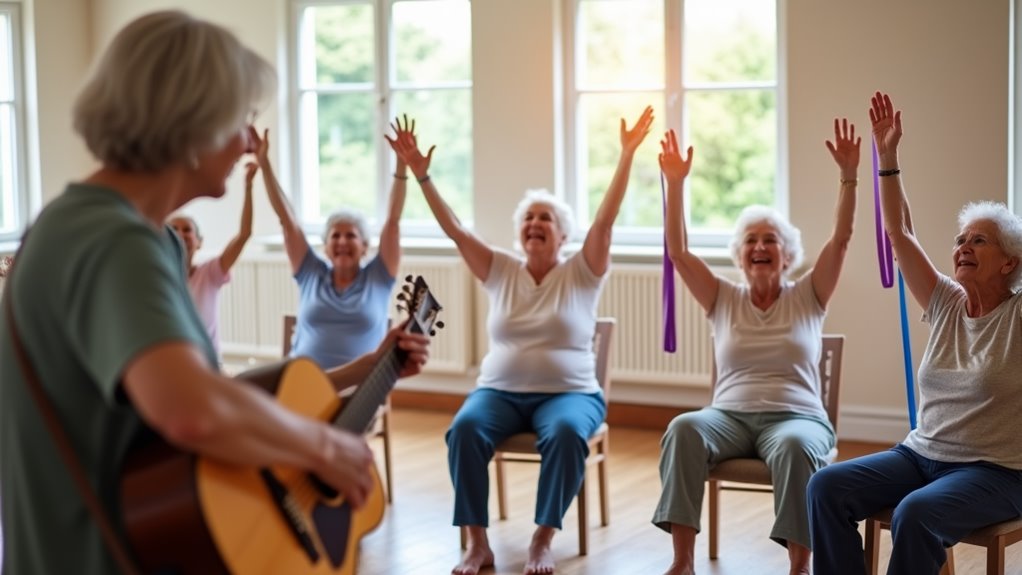Music is a powerful tool that can transform the way we move, think, and feel, especially as we age. For seniors, combining music with exercise does more than brighten a workout; research shows it can improve balance, boost cardiovascular endurance, and make physical activity feel easier and more enjoyable.
This article explores the science behind music and movement, and how music therapy is enhancing the lives of older adults through exercise.
Key Points:
- Music therapy activates multiple brain regions simultaneously, improving cognitive function while seniors engage in physical exercise routines.
- Rhythmic elements in music provide timing cues that help seniors maintain proper pace and coordination during exercise activities.
- Research shows music-enhanced exercise programs achieve 58 positive health outcomes, including improved cardiovascular endurance and flexibility in seniors.
- Music therapy increases program adherence rates by making exercise more enjoyable and creating a motivating social environment.
- Beat-accentuated music in structured exercise sessions helps seniors develop consistent routines while improving strength and coordination.
Understanding Music Therapy and Its Role in Senior Wellness
While music has been used therapeutically for centuries, modern music therapy has emerged as a powerful clinical intervention that’s revolutionizing senior care. This evidence-based practice involves credentialed professionals who use carefully selected musical experiences to achieve specific health and wellness goals for older adults.
Music therapy isn’t just about listening to songs. It encompasses a range of therapeutic activities including singing, playing instruments, and composing music.
These interventions are tailored to address your emotional, cognitive, social, and physical needs through both individual and group sessions.
Physical Benefits of Music Therapy in Senior Exercise
Engaging in activities such as singing, playing instruments, or dancing encourages movement and coordination, which helps improve motor skills and physical function.
These activities not only promote physical activity but also provide cognitive stimulation, making them particularly effective for older adults aiming to maintain or regain mobility.
It also enhances cardiovascular endurance during workouts while making physical activity feel less strenuous.
Cognitive and Emotional Benefits of Music Therapy
Because music therapy engages multiple regions of the brain simultaneously, its cognitive and emotional benefits for seniors extend far beyond simple entertainment.
Music therapy sessions can greatly improve memory recall, especially in those with Alzheimer’s or dementia, while reducing anxiety and depression symptoms.
When you participate in structured music therapy, you’re not just enjoying favourite bangers, you’re activating neural pathways that enhance attention, orientation, and language skills. Meta-analysis shows that music therapy delivers significant improvements in global cognition among older adults.
The emotional impact is equally profound, as you’ll notice decreased agitation and improved mood that can last up to eight weeks after treatment.
How Music Enhances Motivation and Exercise Adherence
A comparison of study groups revealed that seniors engaging in twice-weekly music sessions demonstrated superior fitness outcomes.
Incorporating rhythmic elements into exercise routines greatly increases participation and engagement rates among seniors.
Studies show that music-based exercise programs achieve higher adherence rates compared to traditional programs, largely due to their ability to synchronize movement with consistent beats.
When you exercise to personalized music selections, you’re more likely to maintain a steady pace while experiencing enhanced mood and reduced stress levels.
The combination of rhythmic cues and social interaction creates a powerful motivational environment in community settings.
With 90.6% satisfaction rates reported among participants, music-based exercise programs prove highly enjoyable for older adults.
Practical Applications: Incorporating Music Therapy into Senior Exercise Programs
Implementing music therapy into senior exercise programs requires careful planning and structured protocols to maximize both physical and cognitive benefits.
- Structure programs with beat-accentuated music paired with aerobic, resistance, and balance training exercises.
- Monitor progress using the Senior Fitness Test and Mini-Mental Status Examination (MMSE).
- Deliver sessions in accessible community centers with proper acoustics and ample space.
- Adapt exercises for varying abilities, offering both seated and standing options.
Programs typically run 10-20 weeks, allowing participants to develop consistent routines while building strength and coordination.
References
- https://pmc.ncbi.nlm.nih.gov/articles/PMC8872233/
- https://www.uclahealth.org/news/article/how-music-therapy-helps-older-adults
- https://pmc.ncbi.nlm.nih.gov/articles/PMC10695625/
- https://journals.sagepub.com/doi/10.1177/20592043241268721?icid=int.sj-full-text.citing-articles.3
- https://accscience.com/journal/AC/1/2/10.36922/ac.0396
- https://journals.lww.com/jnr-twna/fulltext/2020/10000/effects_of_an_active_music_therapy_program_on.2.aspx
- https://www.sciencedirect.com/science/article/abs/pii/S1550830720302251
- https://www.southshorehealth.org/wellness/blog/three-benefits-seniors-experience-when-exercising-music
- https://www.scirp.org/journal/paperinformation?paperid=127096
- https://pmc.ncbi.nlm.nih.gov/articles/PMC11012733/




